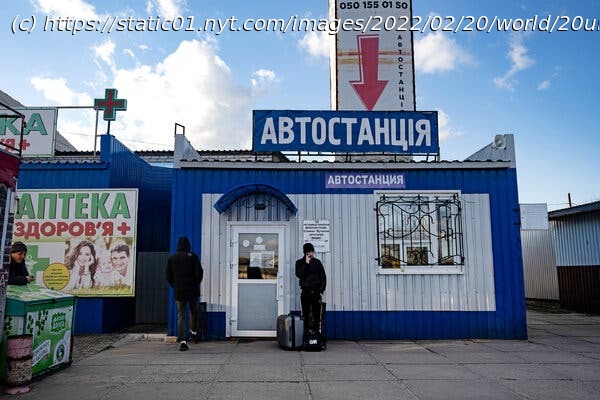Russian-backed separatists in the Luhansk and Donetsk regions once got just passing attention. They loom much larger now as many fear what may come next in Ukraine.
STANYTSIA LUHANSKA, Ukraine — People pass the bare-bones checkpoint dragging wheeled suitcases along the muddy pavement, crossing one of the starkest political divides in Europe today. In pale winter sunshine on Sunday afternoon, Gleb Yegorov,17, made his way into Ukraine after navigating a half-mile buffer zone and then crossing a pedestrian bridge strung over a ravine. Artillery boomed in the distance. Behind him was the Russian-backed separatist enclave known as the Luhansk People’s Republic, which he said he was fleeing to avoid the draft. He barely made it out, he said, after an eight-hour interrogation on the separatist side of the crossing, and would never go back. “There’s no future for me there,” he said. “They send boys to the front and don’t think about it if they die.” For years, the Luhansk People’s Republic and its fellow breakaway Ukrainian enclave, the Donetsk People’s Republic, were largely ignored. They were just two odd little political entities, Stalinist throwbacks with internal politics too esoteric to merit much attention from the outside world. But now that the biggest war in Europe in decades may hinge on them, it sometimes seems as if Luhansk and Donetsk are all anyone is thinking about. With Ukraine surrounded by Russian forces, Western governments warn that Moscow may use the two Russian-backed republics as the stage for a “false flag” attack on ethnic Russian civilians — and then cite it as justification when they storm across the border. The divide between these mini-states and Ukraine is reminiscent of the Berlin Wall — that is, a separation that grew not out of language or ethnicity but from Cold War-style politics. On one side of the roughly 250-mile frontline is Ukraine, a Western-looking nation aspiring to integrate with European democracies. On the other are about 3.5 million people living in virtual police states. The worry is that these territories will become the setting for a catastrophe, whether staged or accidental, that could lead to far wider violence. A stray shell, for example, might hit a residential building, or there could be a terrorist attack on fleeing refugees. Whatever the situation, Ukraine would be blamed, and Russia would have a pretext to invade. Russia, despite repeated accusations from the West, says that it has no intention of invading, and that it simply wants its legitimate geopolitical interests respected. On Sunday evening, the Ukrainian military issued a statement saying the Russian-backed separatists in the Luhansk region had opened fire with heavy artillery on their own capital city “with the goal of blaming the Ukrainian military.” “In the absence of any aggressive action from the Ukrainian defenders, the occupiers themselves are blowing up infrastructure in the occupied territories and firing chaotically on towns,” the statement said. Russian news agencies reported artillery strikes in the area. There were no immediate reports of casualties. While attacking one’s own side to blame an enemy may seem particularly sinister, it would not be the first time it has happened over the eight-year history of the two enclaves. Analysts have suspected numerous violent events to be false-flag attacks.






